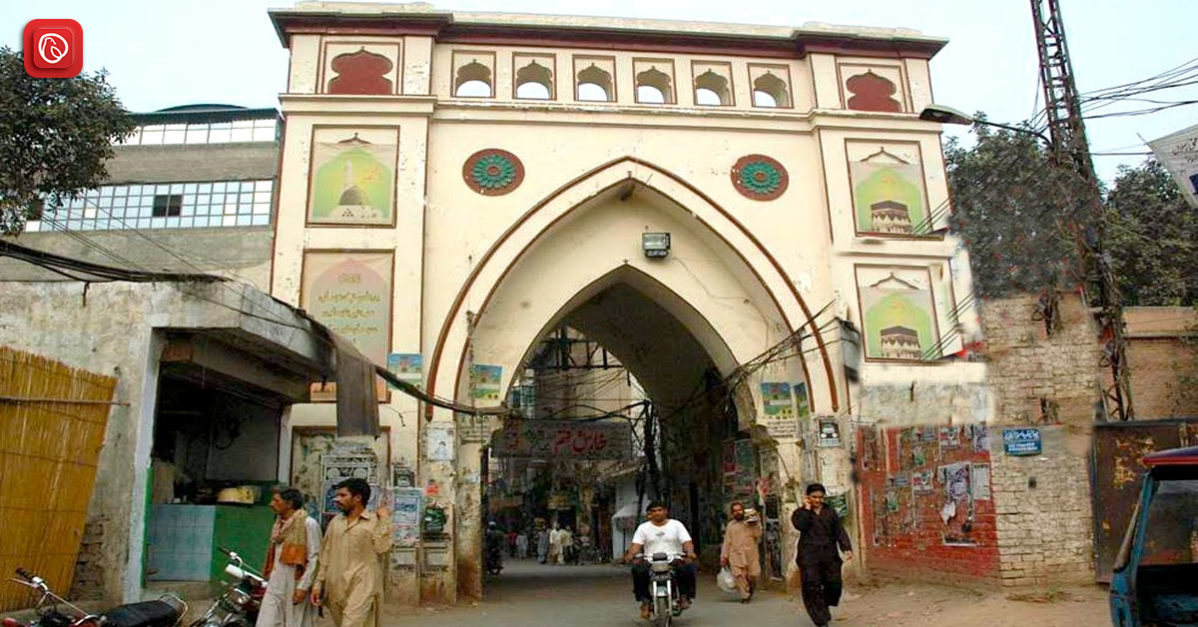
Built into Lahore’s medieval wall, Bhati Gate is a historical landmark and entryway to the rich culture of the ancient city. Named for the Rajput tribe, Bhati Gate has a long heritage as a centre for art, literature, and intellectual pursuits. The region is well known for its mouthwatering cuisine, especially the Bazaar e Hakima, home to traditional healers and fragrant spices. For a peek into Lahore’s soul, stroll around the busy streets or stop by one of the neighbouring mosques or shrines. The famous Data Darbar, a stunning mausoleum and spiritual significance place, is just outside the gate. You can read this blog on Lahore’s ancient Bhatti Gate on Graana.com. Continue scrolling for additional details.
Bhatti Gate is a historic monument enmeshed in the city’s rich history, standing sentinel over the western gateway to the Lahore Fort. Part of the Walled City’s thirteen grand gates, its imposing construction is a monument to the architectural prowess of a bygone period.
The important Sufi shrine Data Darbar is located nearby, adding to the area’s spiritual significance. The worn façade of this gate tells a story of the innumerable tourists and traders who have passed through its arches and left a lasting impression on the busy city of Lahore.
It is located inside the ancient Lahore walled city; therefore, getting there by significant routes will take a lot of work. There will be more minor access roads to navigate on the final approach. Nonetheless, several vital highways offer convenient entry points for travelling to the walled city’s general vicinity:
When you’re near the walled city, ask for directions to Bhati Gate or use GPS navigation software to help you navigate the tiny roads. Most residents should be familiar with Bhati Gate as a landmark.
The architectural story of Bhatti Gate is still a little unclear despite its apparent historical significance. One of the first gates leading into the Lahore Fort was constructed during the Ghaznavid era. Nevertheless, the original architectural style has been hidden over time, and later modifications were made during the British Raj.
The gate’s design likely reflected the luxury of the time, utilising Mughal architectural features, including imposing arches, elaborate tilework, and red sandstone. Regretfully, like Delhi Gate, the reconstruction work may have changed the gate’s original shape or placement.
Unlike some equivalents like Lohari or Delhi Gates, Bhatti Gate lacks internal rooms. Nonetheless, it still serves a practical use because the local police station occupies half of its building. Bhatti Gate is a reminder of Lahore’s rich history, even though its design may not be wholly unique. Its resemblance to Kashmiri Gate provides a window into the possible architectural style that Lahore may have once had.
One of the Lahore Fort’s thirteen historic gates, Bhatti Gate, is more than just an entrance. With its distinctive blend of historical and cultural significance, this western gateway provides a window into the colourful history of Lahore.
Bhatti Gate, nevertheless, has a certain allure in contrast to its more commercialised brethren. It is a flourishing residential neighbourhood that demonstrates how the city is changing.
The intricate pattern of the city is embodied in the gate’s architectural design. Even though more restorations have obscured the specifics, its very existence conveys a great deal about the city’s past.
As a centre of culture, Bhatti Gate lives up to its reputation within the Walled City Lahores winding lanes. It was known as the “Chelsea of Lahore” because it was previously a refuge for artistic expression akin to London’s bohemian neighbourhood. Some of the country’s most well-known poets, artists, and writers grew up in this energetic neighbourhood.
As soon as one steps through the gate, the aroma of delicious local food greets them, confirming the area’s reputation as a gastronomic haven. The holy mausoleum of the Sufi saint Ali Hajweri, Data Darbar, is just past the gate. Here, the beautiful sounds of Qawwali music formerly filled the air; this legacy is carried on in spirit by religious discourses and Naats.
Bhatti Gate is more than just a gateway. It serves as a living reminder of Lahore’s colourful past and symbolises the city’s resilient populace. Bhatti Gate provides an enthralling window into the heart and soul of Lahore, whether it is through the architectural whispers of a bygone age, the echo of creative history, or the perfume of mouthwatering local cuisine.
Here are the FAQS.
Bhatti Gate is one of the thirteen historical gates of the Walled City of Lahore, Pakistan. It’s situated on the western side of the Old City, near the famous Data Darbar shrine.
Bhatti Gate is one of the oldest entry points into the Walled City, dating back to the Ghaznavid period. It’s named after the Bhati Clan and was a crucial control point during Lahore’s early history.
Just outside the gate lies Data Darbar, a revered Sufi shrine. The area surrounding the gate boasts a captivating blend of architectural styles, showcasing remnants of colonial and Sikh eras.
For more information, visit Graana.com.
ISLAMABAD: Capital Development Authority (CDA) is currently undertaking a major Rs652 million project to upgrade…
Karachi – Mayor Barrister Murtaza Wahab has announced the launch of a citywide anti-encroachment operation…
ISLAMABAD: CDA Chairman Muhammad Ali Randhawa has directed the immediate restoration of 23 non-functional water…
ISLAMABAD: In a major relief for the real estate sector, the federal government has decided…
DHA Islamabad-Rawalpindi (DHAI-R), one of the most trusted names in Pakistan’s real estate landscape, is…
ISLAMABAD: Chairman Capital Development Authority (CDA), Muhammad Ali Randhawa, chaired a comprehensive review meeting on…